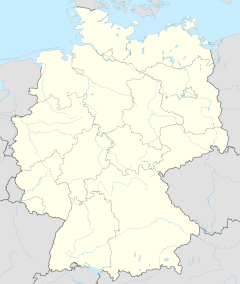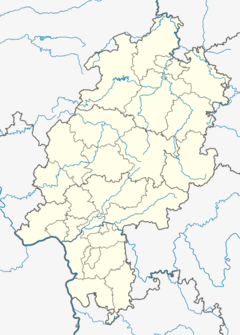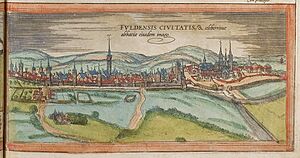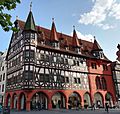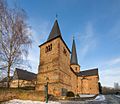Fulda facts for kids
Quick facts for kids
Fulda
|
||
|---|---|---|
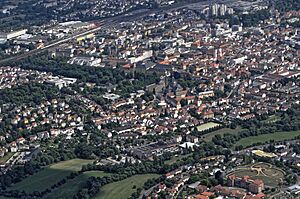
Aerial view of the city center
|
||
|
||
|
Location of Fulda within Fulda district
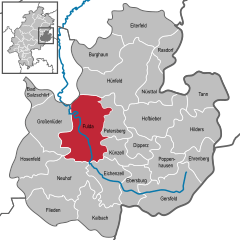 |
||
| Country | Germany | |
| State | Hesse | |
| Admin. region | Kassel | |
| District | Fulda | |
| Founded | 744 | |
| Area | ||
| • Total | 104.04 km2 (40.17 sq mi) | |
| Elevation | 261 m (856 ft) | |
| Population
(2022-12-31)
|
||
| • Total | 69,968 | |
| • Density | 672.51/km2 (1,741.79/sq mi) | |
| Time zone | UTC+01:00 (CET) | |
| • Summer (DST) | UTC+02:00 (CEST) | |
| Postal codes |
36001–36043
|
|
| Dialling codes | 0661 | |
| Vehicle registration | FD | |
| Website | www.fulda.de | |
Fulda (German pronunciation: [ˈfʊlda]) is a city in Hesse, Germany. It is located on the Fulda river. Fulda is also the main city of the Fulda district. In 1990, the city hosted the 30th Hessentag state festival, which is a big celebration for the state of Hesse.
Contents
History of Fulda
Early Beginnings in the Middle Ages
The city of Fulda started with a Benedictine monastery (a place where monks live and work). It was founded in 744 by Saint Sturm. He was a student of Saint Boniface, who was helping to organize the church in Germany during the Carolingian Empire.
The monastery received strong support from powerful leaders. One of them was Carloman, who was a "Mayor of the Palace." This was a very important job in the early Carolingian government. Many rich families also gave money and land to Fulda. This helped the monastery grow and build smaller religious houses nearby.
In 751, Saint Boniface made sure that Fulda was directly under the Pope (the head of the Roman Catholic Church). This meant it was independent and free from control by local bishops or princes. The monastery also became a famous center for learning and education.
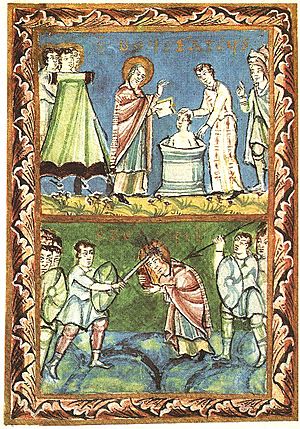
After Saint Boniface died in 754, his remains were brought back to Fulda. This made the monastery even more important. People gave more donations, and Fulda could build more daughter-houses further away.
Between 790 and 819, the monks rebuilt their main church. They wanted a grander place to keep Saint Boniface's remains. They designed the new church like an old church in Rome, making it a special place for pilgrims (people who travel for religious reasons). The old part of the church, called the crypt, still holds Saint Boniface's remains today.
From 822 to 842, Rabanus Maurus was the abbot (head) of Fulda Abbey. Under his leadership, the abbey collected many important books and writings. These included historical texts, religious works, and writings by famous Roman thinkers.
Changes in the 16th to 19th Centuries
In the 16th century, a leader named Balthasar von Dernbach wanted to bring people back to the Roman Catholic Church. He invited the Jesuits (a Catholic religious order) to start a school and college in Fulda in 1571. He also asked the monks to live a stricter monastic life again.
Fulda was a special territory that was only under the German emperor. In 1752, Fulda became a bishopric (an area led by a bishop). The leaders of Fulda were then called "prince-abbots" and later "prince-bishops." They ruled Fulda until 1802, when Napoleon I dissolved the bishopric.
In the 18th century, many beautiful Baroque buildings were constructed in Fulda. This is why Fulda is sometimes called the "Baroque City." Important buildings like Fulda Cathedral (built 1704–1712) and the Stadtschloss (City Palace, built 1707–1712) were remodeled by a famous architect named Johann Dientzenhofer. A porcelain factory also started in Fulda in 1764, but it closed down later.
After Napoleon's time, in 1814–1815, most of Fulda's territory became part of the Electorate of Hesse. Later, in 1866, Prussia took control of this area.
Fulda in the 20th Century
During the Cold War, Fulda was a very important place. It was located near the border between West and East Germany. This area was known as the "Fulda Gap." It was thought to be a likely route if there was a war between NATO (North Atlantic Treaty Organization) and Soviet forces.
Because of this, the United States Army had a large military presence in Fulda. Thousands of American soldiers were stationed there from the end of World War II until 1993. Their job was to watch the border and be ready to defend if needed.
Getting Around Fulda
Fulda station is a major transport hub for trains in Germany. It connects local trains with long-distance ones. The station is on important railway lines, including the Hanover–Würzburg high-speed railway. This line allows very fast trains to travel between cities. Other lines connect Fulda to the Vogelsberg Mountains in the west and the Rhön Mountains in the east.
For road travel, Fulda is located on the Bundesautobahn 7 (BAB 7), which is a major highway. Another highway, Bundesautobahn 66, starts near Fulda and goes south towards Frankfurt. The city is also on Bundesstraße 27, another important road.
Friendship Cities
Fulda has "twin towns" or "sister cities" around the world. These are cities that have special friendly relationships and often exchange visitors or ideas.
 Como, Italy (since 1960)
Como, Italy (since 1960) Arles, France (since 1964)
Arles, France (since 1964) Sergiyev Posad, Russia (since 1991)
Sergiyev Posad, Russia (since 1991) Wilmington, Delaware, United States (since 1997)
Wilmington, Delaware, United States (since 1997) Litoměřice, Czech Republic (since 2001)
Litoměřice, Czech Republic (since 2001) Dokkum, Netherlands (since 2013)
Dokkum, Netherlands (since 2013)
Famous People from Fulda
Many notable people have come from Fulda over the years. Here are a few:
Born Before 1800
- Adam of Fulda (around 1445–1505), a composer and music expert.
- Franz Kaspar Lieblein (1744–1810), a botanist (someone who studies plants).
- Heinrich von Bibra (1711-1788), a prince-bishop and prince-abbot of Fulda.
Born 1801–1900
- Ferdinand Braun (1850–1918), a physicist and electrical engineer. He won the Nobel Prize in Physics!
- Wilhelm Heye (1869–1947), an officer.
- Anton Storch (1892–1975), a politician.
- Wilm Hosenfeld (1895–1952), an officer who helped save many people during World War II. He is recognized as "Righteous Among the Nations."
Born After 1900
- Karl Storch (1913–1992), an athlete who was a hammer thrower.
- Martin Hohmann (born 1948), a politician.
- Tobias Sammet (born 1977), a musician.
- Sebastian Kehl (born 1980), a famous football (soccer) player.
- Patrik Sinkewitz (born 1980), a professional cyclist.
- Damien Haas (born 1990), an internet personality and voice actor.
Images for kids
-
Kloster Frauenberg (Fulda), a Franciscan monastery
-
Weser river watershed, showing Fulda river and the city of Fulda
See also
 In Spanish: Fulda para niños
In Spanish: Fulda para niños



